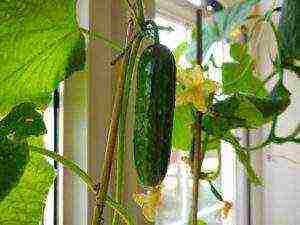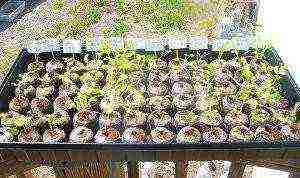Content
- 1 What is a herbicide
- 2 Views
- 3 The most popular potato herbicides
- 4 How are weed killers used?
- 5 The effect of herbicidal treatment of potatoes
- 6 Other products in addition to herbicides
- 7 Why do you need to treat potatoes from weeds?
- 8 Mechanical protection of potatoes from weeds
- 9 Chemical weed control on potatoes
- 10 Properties of the drug "Lazurit"
- 11 Processing methods and times
- 12 Consumption rates
- 13 Contraindications for the use of the herbicide
- 14 Hilling potatoes - increasing the number of tubers
- 15 Weeding potatoes - removing weeds, loosening the soil
- 16 Weed control - special products
- 17 Siderata against potato weeds
- 18 Top dressing of potatoes - for large tubers
It is no coincidence that potatoes have become the most widespread horticultural crop in our country. It is successfully grown in both hot southern and cold northern climates, and yields a rich harvest.... However, even he becomes vulnerable if he has to share a bed of weeds. It is to combat them that herbicides are intended.
What is a herbicide
Herbicides are the collective name for chemicals used to kill pests. The scope of their application is very wide - from industrial construction to the purification of reservoirs. However, they are most fully used in agriculture.
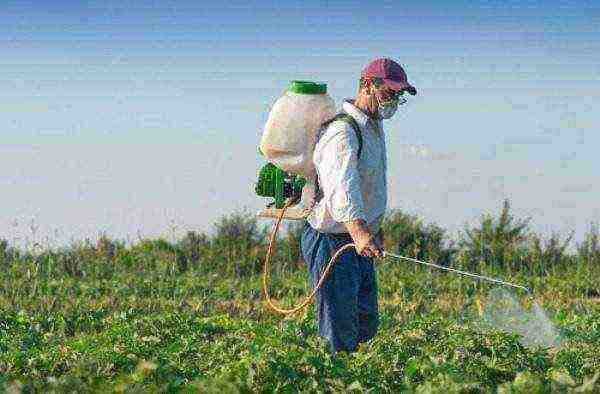 Herbicide treatment will rid potatoes of weeds
Herbicide treatment will rid potatoes of weeds
By the nature of damage to harmful vegetation, preparations are divided into two large subgroups:
- Internal action (systemic) - infect the entire weed plant.
- Outdoor action (contact) - are not absorbed by the root system of the weed plant, but they affect its aboveground part.
The effectiveness of various kinds of herbicides is also different. So, contact varieties, with rare exceptions, are used to combat annual pests. But for more complex root systems of perennial weeds, internal chemicals are indispensable - they are able to kill the entire plant, reduce soil overgrowth in the next season. Often, herbicides of different types are used together.
Views
The preparations also differ in the spectrum of the affected vegetation.... This is very important to consider when choosing chemicals, since an unsuitable agent is able to remove along with weeds and planting potatoes.
The Ministry of Health of Russia annually publishes a list of "Pesticides and Agrochemicals" approved for use.
Continuous action
This type of herbicide is the most deadly, intended for the extermination of all types of plants in the treated area, without exception... Also in agriculture they are called general exterminating, they fully correspond to their formidable name.
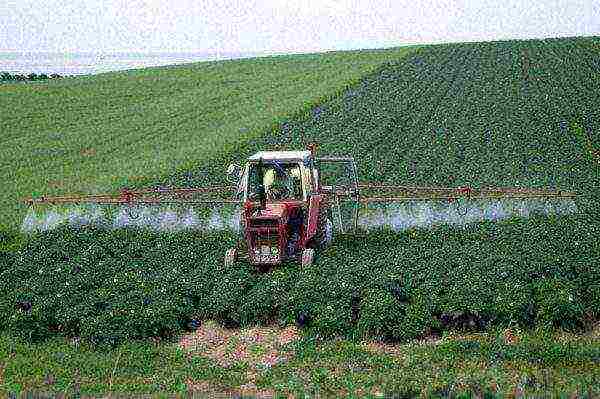 A continuous herbicide will destroy the protective shell of the seedlings, which leads to the death of the future plant
A continuous herbicide will destroy the protective shell of the seedlings, which leads to the death of the future plant
In agriculture, chemicals of this type have a rather narrow application - preparing virgin soil for planting, when it is necessary to remove all biological component from it, without exception. In the conditions of a garden and a vegetable garden, it is not easy for them to find use, sometimes they are used to process beds in the off-season.
Selective action
In the overwhelming majority, weed poisoning refers to substances with a selective or selective spectrum of damage. They are poison only for some plant species, while remaining harmless for horticultural crops. In turn, they are also subdivided into two types:
- Widely selective - fight certain types of flora, for example, all dicotyledonous plants, without touching monocotyledonous plants.
- Narrowly selective - not whole plant species are affected, but individual varieties within species; for example, Grodil struggles with a bedstraw, but does not touch its related barley and other grains.
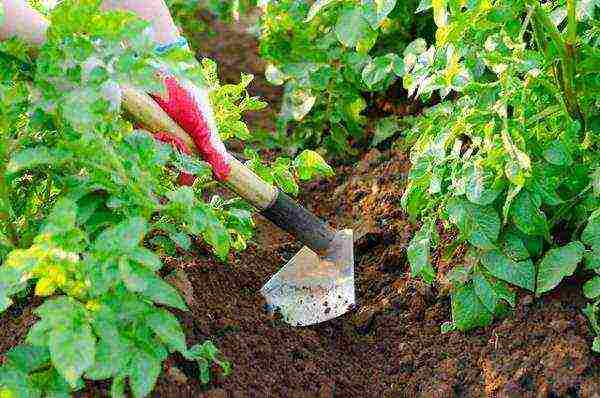 The use of herbicides reduces the number of inter-row potato treatments
The use of herbicides reduces the number of inter-row potato treatments
In fact, almost exclusively selective drugs are used in the household plots, therefore we will pay special attention to them.
Pre-emergence
Also known as soil aids. Their operating principle is well understood from the name - it is necessary to process the soil itself. In addition to weed penetration, some pre-emergence chemicals leave a thin film on the ground. The defeat of pests occurs when their shoots come into contact with it.
Popular pre-germination products:
- Roundup - contains glyphosates; tillage occurs half a month before planting potatoes; shoots and roots of weeds are affected.
- Centurion - pre-emergence herbicide, used to control monocotyledonous weeds, for example, cereals; saturated with ketodimami, absorbed by the root system of weeds, leads to the rapid wilting of sprouts.
- Boxer - effective against all types of pest flora, especially often used for breeding dicotyledons; its active ingredient is prosulfocarb.
Postemergence
Also called leaf preparations, that is, affecting the upper, aerial parts of plants. Most of them use phosphates as an active substance.
Popular remedies used after germination:
- Shogun - it is used against cereal pests; saturated with propaquizafop, applied by spraying in the most active phase of the weed growing season - the formation of 4 leaves, the stem height is 10 cm.
- Alpha Mais - effective against dicotyledonous plants; destroys weeds within 3-10 days after tillage.
- Tornado 500 - saturated with glyphosates, poisonous for all types of dicotyledonous and monocotyledonous plants; the beneficial effect of the drug lasts up to 30 days, regardless of the weather.
Post-emergence herbicide management is less demanding on the tillage process. So, in the case of their use, there are no strict requirements for compliance with the dosage. Even with a lower saturation of drugs per square meter of area, a beneficial effect occurs, but it is expressed not in the complete destruction of weeds, but in a decrease in their germination and the ability to form seeds.
In 2017, the Ministry of Health of Russia approved 291 herbicides for use on the territory of the countries.
The most popular potato herbicides
The modern market is extremely saturated with drugs of various effects. But even among the existing herbicides there are several that gardeners love most due to ease of use and efficiency. What drug to choose for processing potatoes?
Zenkor
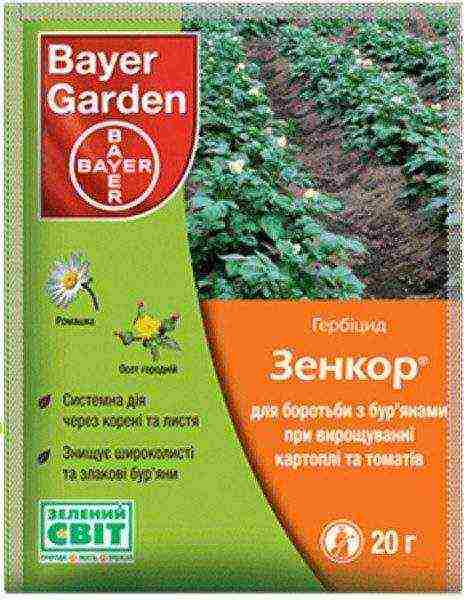 Zenkor
Zenkor
Refers to selective herbicides, completely harmless for nightshades, carrots, potatoes. The chemical is based on the substance metribuzinthat breaks down in the soil no faster than 3 months after treatment. The use of Zenkora is especially beneficial for the control of broadleaf and cereal plants.
Zencor is supplied in both liquid and granular form.
An important advantage of Zenkora is its saturation with an active substance - 600 g / l. In addition to damaging the germs, leaves after application a protective film on the surface of the garden... Works great in mixes as it is compatible with a wide range of insecticides and pesticides.
Titus
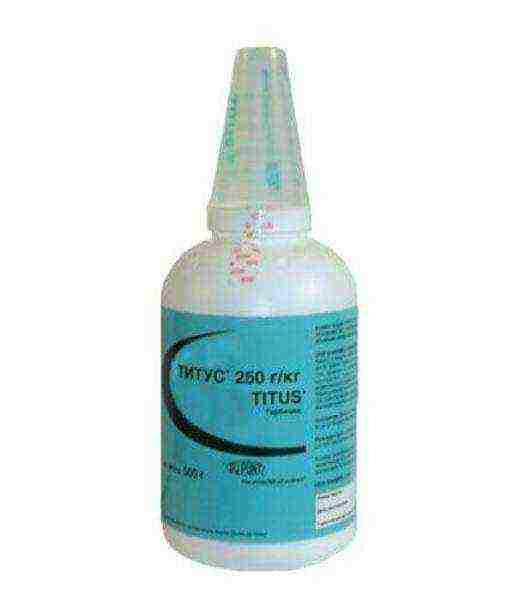 Titus
Titus
It has a selective effect, spraying should be done in the post-emergence period. The active ingredient is rimsulfuron, which blocks the process of acetolactosynthesis in the leaves. Equally effective against one and biennial plants... The first signs of weed death are noticeable after 3 days, and their complete death occurs no later than 15 days after treatment.
Titus is suitable for the preparation of tank mixtures, but incompatible with phosphorus insecticides.Very picky about humidity - with prolonged drought, the consumption of the chemical should be increased. May cause temporary yellowing of potato leaves. Not recommended for use on seed bushes.
Lapis lazuli
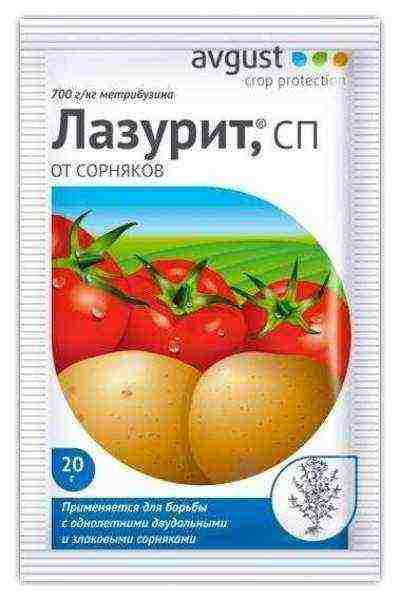 Lapis lazuli
Lapis lazuli
Lapis lazuli is a versatile tool used for both pre-emergence and post-emergence treatment of beds. By the principle of action, it resembles Zenkor - the main substance is also metribuzin (700 g / l).
One of the most powerful drugs, it is used strictly once a season, only in exceptional cases, double processing is allowed - before and after shoots, when the sprouts of potatoes have reached a height of 10 cm or more. You should be very careful with Lapis Lazuli - contact with skin, mucous membranes, eyes or food is fraught with a deterioration in human well-being.
How are weed killers used?
The effectiveness of soil chemicals is extremely dependent on the gardener's compliance with a number of requirements for their use.:
- uniform soil structure - large lumps of earth are not welcome, which impede the uniform distribution of the substance over the surface;
- humidity - it is desirable to moisten the soil before applying herbicides;
- embedment depth - not deeper than 5 cm;
- type of soil - the activity of the preparations will be lower in fertile soils, the humus saturation of which exceeds 5%; preparations are more suitable for sandstones and other types of light soils;
- heat level - when the air temperature is less than 5 ° C, the performance is reduced.
It is also important to keep in mind that in pivot farming - the annual crop rotation in the garden - chemicals can interfere with the normal development of some types of vegetables. Before using herbicides, be sure to study the list of incompatible crops.
The effect of herbicidal treatment of potatoes
The mechanism of action of different types of herbicides is not the same. It depends on their chemical composition and method of application. By the way the chemical manifests itself on plants, the following varieties can be distinguished:
- Destroy cell membranes - lead to drying of weed sprouts; the effect begins to appear immediately after treatment.
- Hormone replacement - the mechanism of action of benzoic or acidic herbicides; destroys the connections of leaf tissues; the effect is weakly manifested in relation to grain varieties of weeds.
- Suppression of photosynthesis - only against dicotyledonous weeds.
- Suppression of the ability of cells to divide - chemicals of this type belong to chloroacetamides; the action is gradual, at first the plant weakens, then dies.
- Suppression of amino acid synthesis - leads to a stop of the development of the weed.
- Suppression of fat synthesis - immediate stop of development, drying of the plant within 15 days.
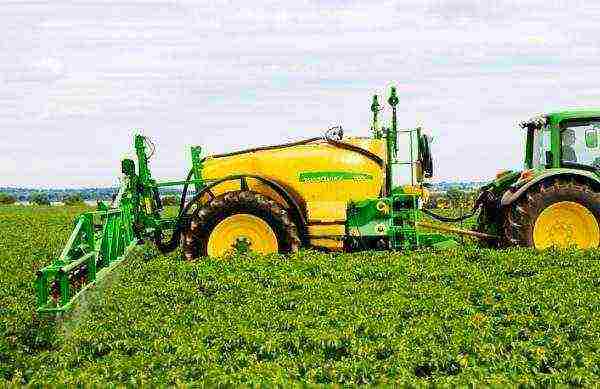 The use of herbicides can completely eliminate the transfer of viruses, which is provoked by damage to the bushes
The use of herbicides can completely eliminate the transfer of viruses, which is provoked by damage to the bushes
Unfortunately, the effect of the use of herbicides is partially manifested on potatoes, especially with incorrect dosage or processing procedure... To minimize it, you can supplement or partially replace the chemicals with less aggressive substances.
Some types of weeds can become addictive to the active ingredients of the chemicals. Therefore, it is not worth using exclusively one type of drugs - replacing the herbicide with another at least once every 3-5 seasons.
Other products in addition to herbicides
Herbicides are not able to provide complete protection against all misfortunes. Depending on the threat, the treatment of potatoes and other crops can be carried out with preparations of the following type:
- Fungicides - to combat fungal spores.
- Insecticides - chemicals that kill parasitic insects.
- Acaricides - against mite infestation of plants.
- Bactericides - prevent the growth of microorganisms.
- Nematocides - against nematode worms.
- Folk remedies - from kerosene to copper sulfate.
Finally, hand weeding is a conventional analogue of chemicals.But even with the most careful removal of weeds, the effect will not be comparable to that after treatment with special means. That's why herbicides remain in demand among gardenerswho have a rich harvest as their priority.
Foreword
Weed control on potatoes is an important and necessary job, without which you can lose your entire crop. And now we will tell you why the removal of weeds from the site is so important, and most importantly, how the work is carried out.
Why do you need to treat potatoes from weeds?
Weeds are one of the main dangers in the country, because this grass competes with crops for nutrients, and also becomes a reserve of many diseases. Therefore, weed control on potatoes is an important job at every site. For example, a shepherd's purse or violet can harbor the potato-damaging virus Y (PVY). In addition, weed-infested plantings of root crops are characterized by a poor microclimate, are not ventilated, which can lead to late blight..
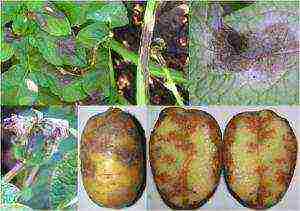
Naturally, weeds make harvesting much harder, increasing the workload of harvesting machinery and equipment, which contributes to increased labor costs. Much worse in quality and appearance are potato tubers harvested from a vegetable garden filled with weeds. Due to the presence of harmful grass, the crop will turn out to be small, the tubers are deformed, as a result of which long-term storage of potatoes in this form is not possible. To avoid many of these problems, it is enough to organize a competent fight with the following plants: sow thistle, highlander, wheatgrass, chamomile, bindweed - all of them can cause irreparable harm to your crop.

Mechanical protection of potatoes from weeds
Undoubtedly, many gardeners will immediately rush to buy various herbicides, choosing the easiest and, in their opinion, the most effective way to remove weeds from the beds. However, one should not be limited only to the use of chemicals. Despite the complexity, mechanical protection of the garden is considered a very effective way.

The first stage of work is the creation of correctly formed ridges. Intensive movement of the land, hilling of potatoes, soil cultivation with a harrow when working on loamy soil allows you to achieve very high performance in the fight against grass. However, on heavy and wet soils, the level of efficiency decreases markedly.

It is also necessary to correctly select a tool for removing weeds, because it is very important not to damage the seedlings, which can also lead to the development of diseases, including rhizoctonia. The best tools include:
- disc hillers;
- spinning hoes;
- brushes:
- scrapers.
Chemical weed control on potatoes
Mechanical weed control will not have the desired effect without the use of chemicals and preparations. When using soil-acting herbicides, you need to consider the following factors:
- Potato tubers must be planted to a sufficient depth so that the effects of herbicides do not spread to them;
- For even distribution of herbicides around the plant, you need to loosen the soil in advance;
- The soil should be well moistened before using various products.
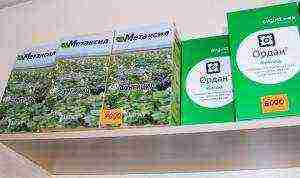
Two to three days after planting the crop, use racer, gezagard, zenkor and lapis lazuli, which can withstand dicotyledonous and cereal weeds. Immediately after germination, it is best to use products such as herbitox, lintaplant and aritox. For a more effective fight against the Highlander, Datura and Thistle, use Zenkor and Titus.
Important: herbicides must be distributed very carefully, accurately calculating the amount of drugs for a given area, so that there is no overdose.
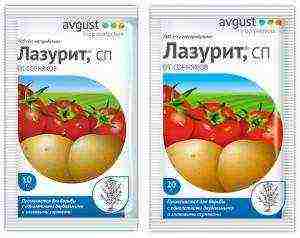
Also, after using herbicides, you need to forget about watering for some time, so that during the work, herbicides do not get into the root zone of the crops, because the preparations can damage the root system of the plants.As you can see, there are various methods of weed control. And in order to achieve the maximum effect from the work carried out, it is advisable to combine them with each other in order to get tasty and beautiful potato tubers that can maintain their qualities for a long time.
Rate the article:
(1 vote, average: 1 out of 5)
Anyone with a garden or vegetable garden knows what weed control is. With each arrival of spring, in addition to pleasant troubles, this irreconcilable battle awaits us. And not always a person comes out the winner in it. Weed grasses are less demanding on growing conditions, they have a better chance of surviving than cultivated plants. For example, potatoes will not survive without a person leaving, without water, feeding.  And weeds grow next to it, on its territory and are its rivals in the fight for nutrients and moisture. If they are not destroyed, then, in addition to a decrease in the commercial quality of tubers, the appearance of all kinds of diseases, inconveniences in collecting potatoes, crop losses can be up to 50%. And this is quite sensitive. Therefore, every weekend poor summer residents spend several hours of their time weeding the garden, instead of spending those hours on more interesting activities.
And weeds grow next to it, on its territory and are its rivals in the fight for nutrients and moisture. If they are not destroyed, then, in addition to a decrease in the commercial quality of tubers, the appearance of all kinds of diseases, inconveniences in collecting potatoes, crop losses can be up to 50%. And this is quite sensitive. Therefore, every weekend poor summer residents spend several hours of their time weeding the garden, instead of spending those hours on more interesting activities.
Properties of the drug "Lazurit"
Some categorically do not recognize chemistry, fearing to poison both the soil and themselves, they fight weeds by mechanical means. Others start looking for helpers. There are several effective recipes for killing weeds when growing potatoes. One of them is the use of herbicides, special preparations for combating harmful plants. For potato processing, there is a group of such products from different manufacturers. Today the drug "Lazurit" against weeds is the main herbicide. It perfectly destroys annual weeds on potato plantings. Penetrating into the leaves, kills them. It also acts for 1-2 months through the soil on growing weeds.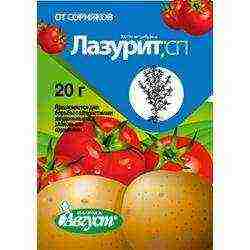
The drug suppresses annual dicotyledonous and cereal pests (cornflower, quinoa, ragweed, Mary, thistle, dandelion, chamomile, thistle and others). At the same time, when used correctly, it does not have a negative effect on potatoes. The "Lazurit" remedy for weeds is produced in the form of a powder, which includes metribuzin 700g / kg. Packaged in 20 g bags.
Processing methods and times
There are two ways to introduce the Lazurit weed control agent. The first is one-time. Soil spraying is carried out before crop emergence at the rate of 0.7-1.4 kg / ha. An important point: the tubers must be deepened into the ground optimally so that the drug cannot affect the sprout zone. For an effective result and even distribution of the product, the soil must be moist, loose and lumpy, the ridges must be well settled. Windless weather is desirable.
Method 2 - double. The first time the soil is sprayed before the potatoes emerge at a rate of 0.5-1 kg / ha. The second time, the treatment is carried out at a dose of 0.3 kg / ha at a potato seedling height of 5 cm and in the period of emergence of 70-80% of them.
Consumption rates
Using the drug "Lazurit" for weeds, you should observe the exact dosage according to the manufacturer's instructions and caution. Immediately before use, prepare a solution: in a large bucket in 1 liter of water, dissolve 1 sachet of the drug, stir and add another 5 liters for primary treatment (before crop sprouting). If the solution is prepared for a secondary procedure, then 1 sachet is diluted in 20 liters of water. The ready-made solution is used immediately, not stored!
 The dosage also depends on the composition of the earth and the humus content in it. The maximum doses of the drug "Lazurit" are used on heavy soils, and on light soils - the minimum. If the soil contains less than 1% humus, then due to its weak absorption capacity, the herbicide is not used at all.On peatlands, soils containing more than 6% humus, wetlands, spraying should be carried out with already grown weeds. On early potatoes, lower consumption rates of the drug are used (no more than 0.5 kg / ha), on later ones, higher ones. The treatment is best done at a temperature of 15-20 degrees C. If it is cooler or it rains after the procedure, the effect is noticeably reduced. After 2 weeks, the weeds die.
The dosage also depends on the composition of the earth and the humus content in it. The maximum doses of the drug "Lazurit" are used on heavy soils, and on light soils - the minimum. If the soil contains less than 1% humus, then due to its weak absorption capacity, the herbicide is not used at all.On peatlands, soils containing more than 6% humus, wetlands, spraying should be carried out with already grown weeds. On early potatoes, lower consumption rates of the drug are used (no more than 0.5 kg / ha), on later ones, higher ones. The treatment is best done at a temperature of 15-20 degrees C. If it is cooler or it rains after the procedure, the effect is noticeably reduced. After 2 weeks, the weeds die.
Contraindications for the use of the herbicide
Do not use the "Lazurit" weed remedy when potato seedlings have suffered from frost, pests, and the shoots are sick or very weak. Also, with the sensitivity of the variety to herbicides, their negative effect on the growth and development of the plant, chemical treatment should be abandoned.
You need to be careful and observe safety precautions when using the "Lazurit" product. Weed control with herbicides eliminates labor-intensive weeding and even increases yields. But it should be remembered that this method is unsafe and justified only when other measures for the destruction of weeds have not been successful.
Growing potatoes is a process with several mandatory steps, the implementation of which ensures the formation of a good harvest.
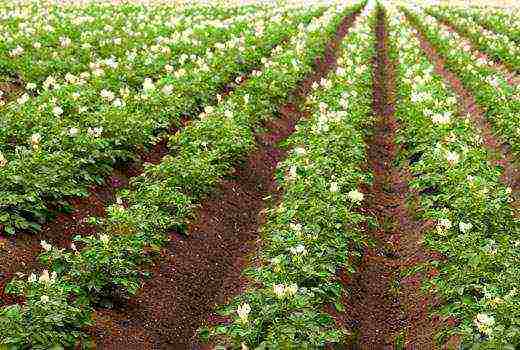
Content
- Hilling potatoes
- Weeding potatoes
- Weed control in potato beds
- Siderata against potato weeds
- Top dressing of potatoes
Hilling potatoes - increasing the number of tubers
Hilling is the process by which potato stalks are covered with earth. This is the simplest technique that gives very good results when done correctly. The fact is that potato stalks, when they enter a favorable environment (fertile soil), change and begin to actively grow the so-called stolons, on which additional potato tubers are tied over time. In this case, the increase in yield can reach 1/3.
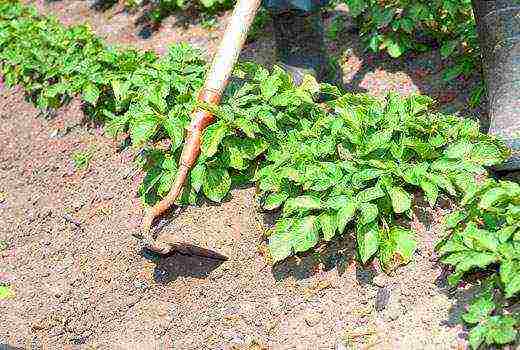 Hilling potatoes can increase the yield by almost a third
Hilling potatoes can increase the yield by almost a third 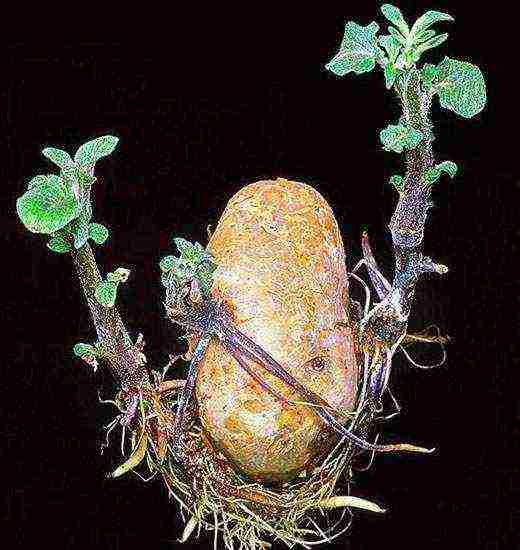 After hilling, additional potato roots begin to grow - stolons
After hilling, additional potato roots begin to grow - stolons
By the way, hilling potatoes has another meaning. Early potatoes are planted so early that by this time there is still a risk that frosts will suddenly come. In such a situation, the plants can freeze over and, if not die, then be significantly damaged. In such a situation, hilling potatoes will be a real salvation. You just need to cover the bushes almost to the very top, and the harvest will be saved.
If the potatoes are planted not too early, when the threat of frost has passed, hilling is carried out when the stems of the bushes reach a height of 20 cm. For it, they take land between the beds. Ideally, after hilling, you should get even beds in the form of mounds, above which only the very tops of the bushes rise (3-5 cm is enough).
After that, they wait about 3 weeks, after which they re-hilling. By this time, the tops of the potatoes will grow a lot, so the stems can again be covered with a layer of garden soil.
The second hilling usually occurs during the budding period, that is, during the setting of flowers. It is during this period that potato tubers begin to gain mass intensively. If hilling is done on time, the results are truly excellent.
Hilling potatoes is very simple. The main thing is, even when planting planting material, take into account not only the fact that the bushes will need a place for development, but also the need for high-quality hilling. After all, if the rows are tightly adjacent to each other, it will not be possible to huddle them properly due to lack of land.
Weeding potatoes - removing weeds, loosening the soil
A simple potato care activity like weeding also has its own secrets. Try to carry out the first weeding when the potato shoots are just emerging from the ground.It is not necessary to use a chopper - you can get by with an ordinary rake.
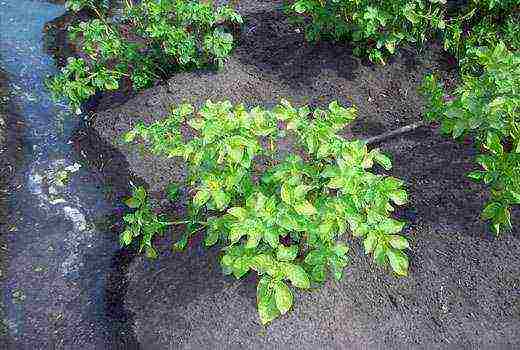 After weeding, the soil around the potato bushes is loose, more oxygen is supplied to its roots
After weeding, the soil around the potato bushes is loose, more oxygen is supplied to its roots
"Prose" them with the site. This will disturb the roots and stalks of weeds, which during this period are still small, but, unlike potato ones, are also thin as strings. Such weeding will significantly reduce the amount of weeds in the beds, and the second weeding (before hilling) will be easier to carry out. Most often, 2 weeding is enough - then the bushes close up, and little weeds grow on the beds.
Weed control - special products
If the site is severely neglected, you can use special biochemical agents to destroy weeds in the beds. Many of them are pre-emergence (Boxer, Reglon Super, etc.), that is, you need to spray the area before the potatoes have not yet appeared above the ground, and the weeds are already there. But there are also means that kill weeds, but do not have a harmful effect on potatoes (for example, Lapis lazuli). By the way, in order to get the most benefit, weed repellents such as Lapis Lazuli are used twice. The first time is before the potato sprouts, and the second time when about 80% of the sprouts are sprouting.
Siderata against potato weeds
One of the most common ways to combat harmful weeds (for example, wheatgrass) is to grow green manure. For example, winter rye has proven itself as a wonderful green manure, which should be sown tightly in the fall, when the entire crop has been harvested. In the spring, rye will sprout and begin to grow vigorously. At this moment, it is completely mowed with a flat cutter or oblique, after which the site is deeply dug up or plowed. After 2 weeks, potatoes can be planted in this place.
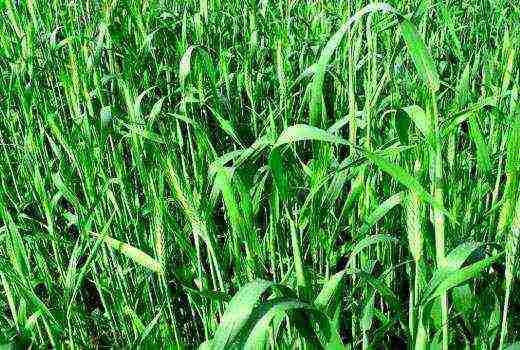 Rye heals the site
Rye heals the site
Winter rye has the ability to disinfect, heal the soil, improve its structure and suppress the growth of weeds. Of course, it will not be possible to completely get rid of the weed problem in 1 year, even if the rye is sown as densely as possible. However, the effect will be noticeable after the first attempt, and after 3 or 4 years the area will be clean.
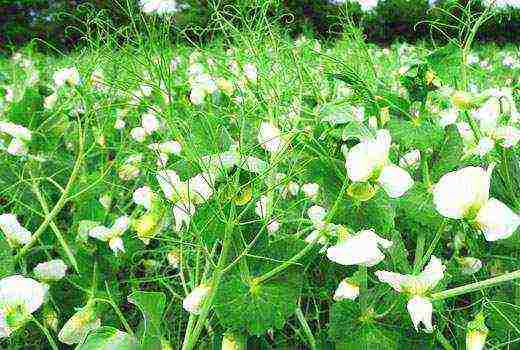 Peas - green manure, leaving behind a lot of nitrogen and phosphorus in the soil
Peas - green manure, leaving behind a lot of nitrogen and phosphorus in the soil
By the way, experienced gardeners often fight wheatgrass using the same wheatgrass. To do this, in the spring, wheatgrass is mowed at the root, then beds are formed on the site and potatoes are planted in them. Potato bushes are spud with mown wheatgrass, which, if necessary, is mixed with leaves, plant residues and mowed grass.
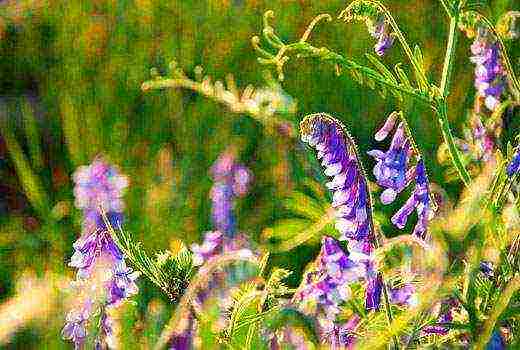 Vika as a siderat - fertilizes the site
Vika as a siderat - fertilizes the site
At the same time, the layer of grass creates unfavorable conditions for the growth of wheatgrass. Other types of weeds, not so tenacious, even die due to lack of sunlight and high humidity. Less hardy weed species simply overheat.
Top dressing of potatoes - for large tubers
Top dressing of potato bushes is especially important in cases where fertilizers have not been applied to the soil for quite a long time, and the summer is rich in rains, which wash away the remnants of nutrients.
It is better to feed potato bushes during hilling. Moreover, it is better to do it twice a season.
The first feeding is carried out already a month after planting the planting material, depending on the region, it can be May or June. During this period, it is recommended to use urea (10 g), superphosphate (20 g) and potassium chloride (10 g). All ingredients are dissolved in 10 liters of water and, before hilling, 1 liter of the above solution is poured under each bush.
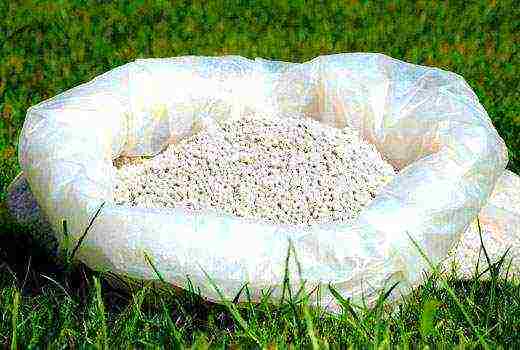 Mineral feeding stimulates the development of potato tubers
Mineral feeding stimulates the development of potato tubers
If, for some reason, it is not rational to add complementary foods (for example, during the period of heavy rains), you can scatter fertilizers in a dry form. Rainwater will dissolve the granules, the substance will penetrate into the soil on its own.
The second potato groundbait is carried out when buds begin to form on the plants. Sometimes, if the soil is completely thin, it is recommended to feed the potatoes for the third time. This is done after the plants have faded.
Depending on the need and preferences, fertilizers such as superphosphate, potash and nitrogen fertilizers can be used. Potatoes also respond well to organic fertilizers, such as rotted manure, bird droppings, humus, or rotted residues of plant waste.
|
Leave your review |
|
| I am not a robot. | |
|
send
Reset |
|
Average rating: 0 reviews
